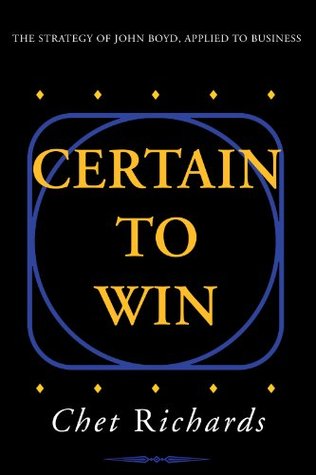More on this book
Community
Kindle Notes & Highlights
Read between
May 27 - May 29, 2017
Boyd was famous for browbeating his audiences with the mantra, “People, ideas, and hardware—in that order!”
This might lead one to suspect that in any competitive endeavor, if you can be modeled (“sand-tabled,” as Boyd referred to it) you aren’t using strategy at all, and you can be defeated.
Boyd concluded that to be most effective, training and shared experiences must expose the organization to more and more complex and dangerous situations so that people finally learn to trust each other in the confusion of conflict.
Zen and other oriental philosophies talk at great length about intuitive knowledge, but they also stress that it comes through years of experience and self-discipline.
A maneuver warfare military believes it is better to have high levels of initiative among subordinate officers, with a resultant rapid Boyd Cycle, even if the price is some mistakes.
Boyd inferred that if you can do things before the other side reacts, you can greatly increase your chances of winning, and it doesn’t make much difference how big or how strong the other guy is.
Since what you’re looking for is mismatches, a general rule is that bad news is the only kind that will do you any good. To thrive in any form of maneuver conflict, you must seek out and find data that don’t fit with your current worldview and you must do this while there is still time. Otherwise the world will change—or more likely your adversaries or competitors will change it for you—and you will find yourself disoriented and in the position of playing catch-up. You will have lost the initiative, which is dangerous in any conflict.
This is a critical idea that is often misunderstood: You are simultaneously observing any mismatches between your conception of the world and the way the world really is, trying to reorient to a confusing and threatening situation, and attempting to come up with ideas to deal with it.
So winning requires more than the promise of survival. It must offer an idea of such power and appeal that people will, at times, neglect their other responsibilities and work nights and weekends and extend trips to make it happen.
A plan is an intention about how to get from where we are now to where we want to be in the future. It is an intention because although we may plan to accomplish certain things, whether we actually do, and whether they have the effects we want, depends on factors beyond our control: customers, competitors, governments, and acts of God, to name a few. The term strategy will be used for higher-order devices for creating and managing plans.
Strategy, then, includes selecting the view of the future we want, creating devices to harmonize all the plans and actions designed to achieve that future, and on relatively rare occasions, shifting to an alternate future.
Strategy is a mental tapestry of changing intentions for harmonizing and focusing our efforts as a basis for realizing some aim or purpose in an unfolding and often unforeseen world of many bewildering events and many contending interests.
Smooth upward communications is not as easy as it might seem. Some of the news may be bad, or may reveal mistakes or poor judgment on the part of the person doing the communicating. Still, the boss has to know, if he or she is going to form a true appreciation of the situation, and the sooner the better. Obviously arranging the work environment so that people will report failure or mistakes to persons who can immediately fire them requires a high level of mutual trust, and is yet another example of why trust is The Way of Management and Leadership.
Gary Klein, in his seminal work, Sources of Power (another book, which along with his next, Intuition at Work, should be in every manager’s and strategist’s desk drawer), illustrates the intuitive / implicit nature of a business contract (drawing on Karl Weick’s version of a conversation between a boss and a team member): • Here’s what I think we face • Here’s what I think we should do, and why • Here’s what we should keep our eye on • Now, talk to me132 The only thing needed to make this into a mission order is to look your subordinate right in the eyes and say, • Here’s what I
...more
The point is that although goals are one way to focus people’s efforts, they should be used sparingly.
If you are going to use goals anyway, never impose them on someone else or on yourself without explaining where they came from and why they’re important. Any mission should include a statement of the commander’s intent (“in order to” or equivalent) and information on missions two levels up. Same is true should you decide to assign a goal.


